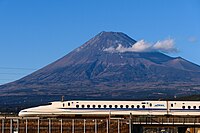
Photo from wikipedia
ABSTRACT The hunting motion of a passenger coach is investigated using a multibody system in which the wheelsets and the rails can be modelled as flexible bodies. By comparing the… Click to show full abstract
ABSTRACT The hunting motion of a passenger coach is investigated using a multibody system in which the wheelsets and the rails can be modelled as flexible bodies. By comparing the results for different model variants, in which the structural flexibilities of the wheelsets and of the rails are either taken into account or neglected, the impact of the flexibilities is analysed. It turns out that the flexibilities of both the wheelsets and the rails have a significant impact on the hunting behaviour by increasing the lateral motions of the wheelsets and lowering the critical speed. In order to investigate the impact of the flexibilities under different operating conditions, the calculations are carried out for track geometries using different rail profiles (60E1, 60E2) and different rail cants (1:40, 1:20) and for different values for the friction coefficient (0.25…0.4) at the wheel–rail contact. The results show that the influence of the flexibilities is the strongest for high lateral forces, which occur e.g. for contact geometries leading to high hunting frequencies and for high values of the friction coefficient. The results also show in some cases a strong impact of the flexibilities on the position of the wheel–rail contact on the running surface of the rail, which is of particular interest with respect to wear simulation.
Journal Title: Vehicle System Dynamics
Year Published: 2019
Link to full text (if available)
Share on Social Media: Sign Up to like & get
recommendations!